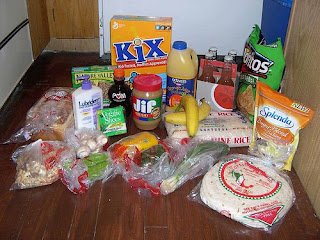How Much 10 Common Grocery Items Cost Savvy Shoppers
 After following sales and coupons religiously for several months, I’ve started to get a sense of the best prices for various items.
After following sales and coupons religiously for several months, I’ve started to get a sense of the best prices for various items. The best way to get these prices is to use the Coupon Mom method of combining a store’s loyalty card discount with sales and coupons. However, over the last several months, it has been possible to get some of these prices without additional coupons from the Sunday paper by either cutting out a store coupon from the store’s weekly circular ad or by printing a coupon for free from Coupons.com.
I was able to get most of these prices at the major chain grocery stores that are located almost everywhere in the United States under different names: Safeway, Vons, Kroger, Randalls, Albertsons, Ralphs, Pavillions, Tom Thumb, Carr’s, Dominick’s, Fred Meyer, QVC, and so on. Some of the lowest prices I found were at small, local chain stores, but I didn’t need a warehouse club membership to get any of these deals.
Soda: For a 12-pack of 12-ounce cans of soda made by Coke or Pepsi, I’ve paid between $2.00 and $2.60 (not the “regular price” of $6.00). The lowest price I’ve seen for 2-liter bottles is 79 cents each. Personally, I prefer the cans since you can drink them at your leisure without worrying about the soda going flat. If I had a larger household full of soda drinkers, the 2-liter bottles might be a better deal. If you don’t mind off-brand soda, you can get good deals without waiting for a sale (and the best deal of all is to just drink water, of course).
Boneless, skinless chicken breasts (fresh, not frozen): I thought I got a deal one week when I paid $3.50 a pound (half off the sticker price of $6.99 a pound), but once I started paying more attention I noticed that I could get the same thing for $1.50 to $2.69 a pound. There never seem to be coupons for this item, only sales. When the price is low, I stock up on as much as I can fit in my freezer since we eat a lot of chicken. It’s healthier than corn dogs or hamburgers and cheaper than fish.
Salty Snacks: The regular price on Wheat Thins can exceed $3, but the sale price for a small box is generally around $1.69. I recently printed some $1.00 off coupons from Coupons.com, so I’ll be getting my next two boxes for 69 cents each. Along similar lines, chips shouldn’t cost you more than $2 a bag, if that. On sale, I’ve seen Pringles for $1.00, Doritos for $1.69, Ruffles for $1, Sun Chips for $2, Mission tortilla chips for 99 cents, and on the list goes. Pay attention to your store circulars to find these deals. Sooner or later, your favorite brand will be a bargain.
Milk: If you’re paying more than $2.00 a gallon, you’re overpaying. At least one store in my area has this price every week. The Safeway family of stores, at least where I live, generally requires you to buy 2 gallons to get this price, but other stores will give it to you with the purchase of just one gallon.
Ice cream: Where I live, a half gallon of Breyer’s ice cream costs $6 at regular price. On sale, it costs around $2.50, and the Proctor & Gamble Brand Saver coupons that come with the Sunday paper once or twice a month often have a coupon. Most of the time, I only pay $2 for a half gallon of name-brand ice cream. Premium ice creams like Starbucks (my favorite), Ben and Jerry’s, and Haagen Daas also go on sale for as little as $2.50 some weeks (unfortunately, I rarely see coupons for these). And while drugstores rarely have spectacular deals on food, they do sometimes have cheap prices on ice cream.
Eggs: I remember five years ago being able to buy a dozen eggs for less than a dollar. Now it seems the price has multiplied, and with the increased popularity of cage-free eggs and the like, it’s not uncommon to see a dozen eggs with a price tag of over $4. The last time I bought eggs, I used a store circular coupon to get 18 for 99 cents. I used two store circular coupons on two separate trips to get a total of 36 eggs for $2. This was a spectacular deal that I don’t expect to get every week, but I won’t pay more than $1.50 for a dozen. Eggs tend to last longer than their expiration date would have you believe if your fridge is cold enough, so I tend to buy two or three dozen when the price is right.
Butter: I used to think $2.50 was a good price for a pound of butter, but recently I’ve gotten it for as little as 52 cents. A flurry of good butter deals over a period of about two months has me stocked up on butter–I have three packs in the fridge and another three in the freezer. It will probably last me through the end of the year, and the most I paid for any of those packs was $1/lb.
Cheese: For plain old cheddar cheese, you’re throwing money away if you’re paying more than $2.50 a pound. Safeway regularly puts their 32 ounce blocks of cheddar on sale for $5. It’s easy to pay more, but there’s no reason to. Of course, you will have to put in the extra effort to grate it or slice it yourself.
Cereal: I can no longer bring myself to pay more than $2.00 for a box of brand-name cereal. At full price, most cereals seem to cost around $4. I usually get mine for $1.25 or $1.50 using a combination of sales and coupons. Some brands go on sale frequently (like Cap’n Crunch and Life) while others you have be patient for (like Banana Nut Cheerios).
Produce: I’ve purchased a 5-pound bag of Russet potatoes for $1, a pound of carrots for 25 cents, and large yellow onions for 25 cents — and these deals were pretty easy to find. Some of them weren’t even sale prices. If you start paying attention, you’ll probably notice that some grocery stores in your area have drastically cheaper produce on a regular basis (hint: they’re probably not the big chains). I purchased cherries for 99 cents a pound by going to one such store in my area. Also, if you have a store that marks down its produce right before it’s about to go bad, you can save a bundle. If I can get a deal on produce this way, I’ll go on a vegetable-eating binge for 24 hours or freeze the stuff. Of course, the best way to get cheap produce is to grow it yourself, but I’ll save that for another post.
Even if you hate to track sales and clip coupons, if you do it for just the ten items that you purchase the most often, you can save a bundle. Then you’ll have extra money to buy more food, spend on something else, or put in your piggybank.
Related posts:


Comments
I think an important thing to mention here is to not be brand specific. The more flexible you are with the brands of your staples the easier it is to find deals.
Additionally, a number of the items you describe are driver items for stores. This means that stores use their prices to drive traffic into the store. The key is to have the discipline to only purchase the items on special. If you lose focus then all that saving on your staples items goes out the window for spending on those impulse items. But otherwise great advice on paying attention to usual prices. This is something every shopper needs to be aware of when they enter the store.